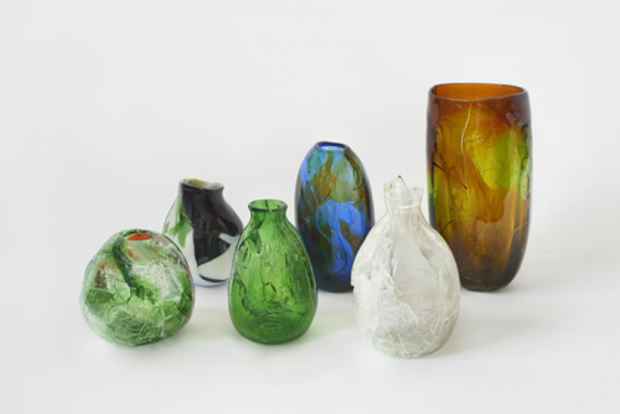“Dead Horse Bay: The Glass Graveyard of Brooklyn” Exhibition
UrbanGlass

[Image: David Horvitz, Unique hand-blown sea-glass sculpture, dimensions variable]
This event has ended.
Curated by Allison C. Meier
Exhbiting artists include: Nicole Antebi, Gerard Barbot, Alex Branch, Yael Eban, David Horvitz, Nathan Kensinger, Jackie Mock, Rose Nestler, Rachel Owens, Amanda Patenaude, Anna Riley, Mark Splatter, and Brett Swenson
It is easy to forget Dead Horse Bay exists. Cradled by a slender curve of shore on the southern edge of Brooklyn, between Marine Park and Jamaica Bay, it feels sequestered from the rest of New York City. Except every aspect of Dead Horse Bay is embedded with the city’s history, from its topography shaped by Robert Moses, to its name referencing the horse rendering plants that were among many unsavory businesses that disrupted its ecology in the 19th century. And then there’s the trash strewn on its beach, where everything not decomposed since the landfill beneath was closed in the 1930s is slowly revealed by the waves.
When walking along the shore of Dead Horse Bay, you soon hear the clinking sound of glass bottles as the Atlantic Ocean laps against the sand. On the beach, there is glass of every variety, from amber bleach jugs to delicate and clear perfume bottles, to green soda bottles, and blue medical bottles. Nowhere else in the city, perhaps, is the connection of glass to our daily lives so evident, as in this detritus of lives lived decades ago.
Dead Horse Bay is essential to explore now, as it is a site of disparate tensions. There are the plants and animals attempting to live alongside the visible pollution, and the consideration of greater planetary concerns with climate change threatening rising currents, which could submerge this strange place. And there’s the conflict between artists who use this as a resource and site of inspiration, and those who see it as protected as any federally-controlled park, even if it’s toxic litter. Finally, it’s the idea that in a city so dense, so developed, that there are these overlooked locations that remain, that are unpleasant and ignored, yet can tell us so much about our history and our individual impact on the world. Now our trash is mostly whisked away from the city, seemingly vanishing; here is evidence that it does not go away.
As an exhibition theme, Dead Horse Bay offers a chance to examine reuse of glass, the history of glassware in consumer goods, and how the sonic and tactile experience with glass at the place, in all its luminous colors, can be an unexpected muse.
About the curator: Allison C. Meier is a Brooklyn-based writer focusing on the arts and overlooked history. Currently, she is staff writer at Hyperallergic, and moonlights as a cemetery tour guide at New York burial grounds. She’s also worked as the senior editor at Atlas Obscura and has published stories for the New York Times, Art Desk, ARTNews, Narrative.ly, Brooklyn Based, the Oklahoma Gazette, Oklahoma Today Magazine, Bust, and others.
Media
Schedule
from February 01, 2017 to April 01, 2017
Opening Reception on 2017-02-01 from 18:00 to 21:00